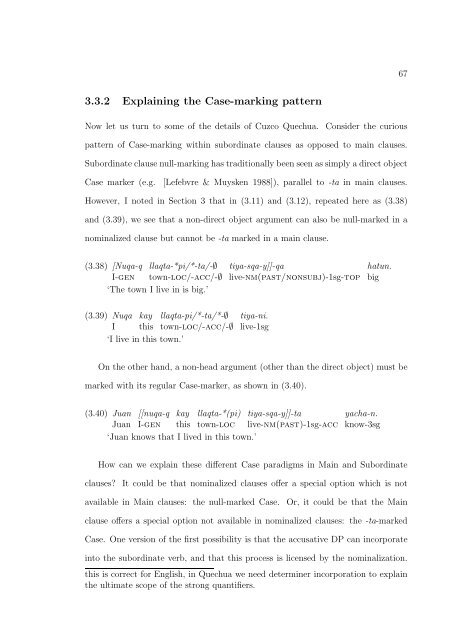the syntax and semantics of relativization and quantification
the syntax and semantics of relativization and quantification
the syntax and semantics of relativization and quantification
Create successful ePaper yourself
Turn your PDF publications into a flip-book with our unique Google optimized e-Paper software.
67<br />
3.3.2 Explaining <strong>the</strong> Case-marking pattern<br />
Now let us turn to some <strong>of</strong> <strong>the</strong> details <strong>of</strong> Cuzco Quechua. Consider <strong>the</strong> curious<br />
pattern <strong>of</strong> Case-marking within subordinate clauses as opposed to main clauses.<br />
Subordinate clause null-marking has traditionally been seen as simply a direct object<br />
Case marker (e.g. [Lefebvre & Muysken 1988]), parallel to -ta in main clauses.<br />
However, I noted in Section 3 that in (3.11) <strong>and</strong> (3.12), repeated here as (3.38)<br />
<strong>and</strong> (3.39), we see that a non-direct object argument can also be null-marked in a<br />
nominalized clause but cannot be -ta marked in a main clause.<br />
(3.38) [Nuqa-q llaqta-*pi/*-ta/-∅<br />
I-gen town-loc/-acc/-∅<br />
‘The town I live in is big.’<br />
tiya-sqa-y]]-qa<br />
live-nm(past/nonsubj)-1sg-top<br />
hatun.<br />
big<br />
(3.39) Nuqa<br />
I<br />
kay<br />
this<br />
llaqta-pi/*-ta/*-∅<br />
town-loc/-acc/-∅<br />
‘I live in this town.’<br />
tiya-ni.<br />
live-1sg<br />
On <strong>the</strong> o<strong>the</strong>r h<strong>and</strong>, a non-head argument (o<strong>the</strong>r than <strong>the</strong> direct object) must be<br />
marked with its regular Case-marker, as shown in (3.40).<br />
(3.40) Juan<br />
Juan<br />
[[nuqa-q<br />
I-gen<br />
kay<br />
this<br />
llaqta-*(pi)<br />
town-loc<br />
tiya-sqa-y]]-ta<br />
live-nm(past)-1sg-acc<br />
‘Juan knows that I lived in this town.’<br />
yacha-n.<br />
know-3sg<br />
How can we explain <strong>the</strong>se different Case paradigms in Main <strong>and</strong> Subordinate<br />
clauses? It could be that nominalized clauses <strong>of</strong>fer a special option which is not<br />
available in Main clauses: <strong>the</strong> null-marked Case. Or, it could be that <strong>the</strong> Main<br />
clause <strong>of</strong>fers a special option not available in nominalized clauses: <strong>the</strong> -ta-marked<br />
Case. One version <strong>of</strong> <strong>the</strong> first possibility is that <strong>the</strong> accusative DP can incorporate<br />
into <strong>the</strong> subordinate verb, <strong>and</strong> that this process is licensed by <strong>the</strong> nominalization.<br />
this is correct for English, in Quechua we need determiner incorporation to explain<br />
<strong>the</strong> ultimate scope <strong>of</strong> <strong>the</strong> strong quantifiers.
















